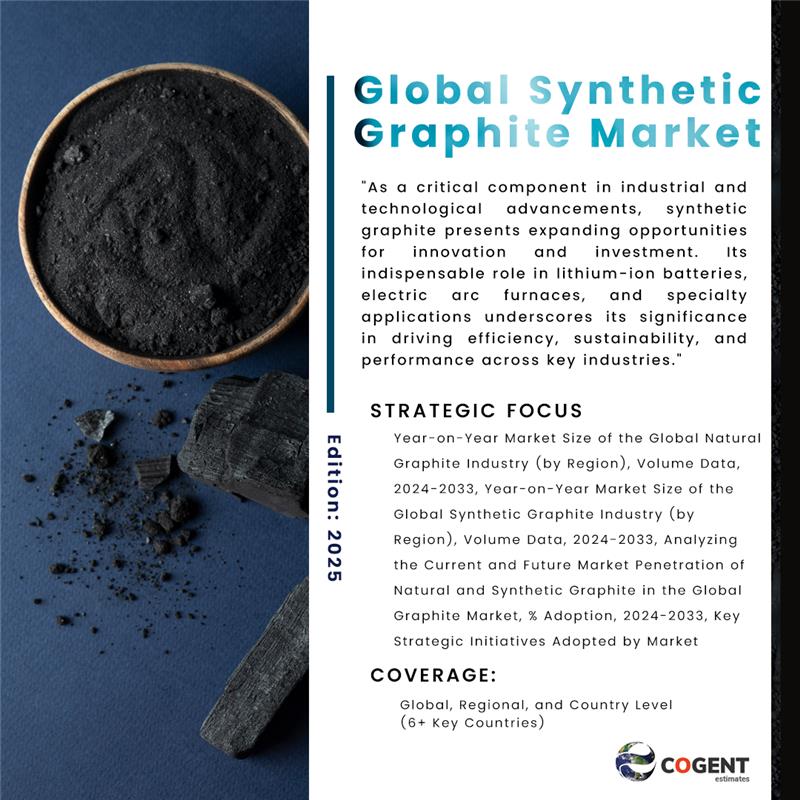
Explore the global synthetic graphite market—covering production, applications in EVs and fuel cells, key grades, sustainability trends, and leading companies like Vianode.
Introduction to the Synthetic Graphite Market
The global synthetic graphite market is gaining momentum due to its growing relevance in advanced manufacturing, clean energy, and electric vehicle (EV) technologies. Synthetic graphite is prized for its superior electrical conductivity, thermal resistance, and strength-to-weight ratio—properties essential to energy-intensive and high-performance applications.
To receive the detailed Table of Contents or request pricing for this report, please email us at contact@cogentestimates.in or submit your query via our Research Request Portal.
How Synthetic Graphite is Produced
Synthetic graphite is manufactured by blending calcined petroleum coke or coal tar pitch with binders. This mixture is molded into desired shapes and heat-treated at temperatures exceeding 2500°C. After graphitization, optional refining steps and silicon carbide coatings improve durability and industrial performance—making the material ready for use in high-demand sectors.
—
Grades and Purity Levels in the Synthetic Graphite Market
The synthetic graphite market categorizes products by purity:
Below 99% Purity: Suitable for general industrial use (e.g., brake linings, foundry applications)
Above 99% Purity: Used in sensitive, high-tech systems like lithium-ion batteries and fuel cell plates
—
Production Timelines Based on Application
The production timeline varies by graphite grade:
Fine-Grain Synthetic Graphite: 6–12 months (multiple impregnation and baking cycles)
Coarse-Grain Grades: 3–4 months (less processing, suitable for less-demanding applications)
This production flexibility enables the synthetic graphite market to serve both high-precision and bulk-use applications effectively.
—
Key Applications Driving the Synthetic Graphite Market
Synthetic graphite plays a crucial role across multiple sectors:
Electric arc furnaces (EAFs) for steel production
Friction materials (brake pads, clutch facings)
Foundry facings and molds
Electrical carbons for motors and generators
Fuel cell bipolar plates
Lithium-ion battery anodes
With EV adoption rising globally, the synthetic graphite market is experiencing exponential growth in the battery materials segment.
—
Synthetic Graphite in Lithium-Ion Batteries
A major driver of the synthetic graphite market is its application in lithium-ion battery anodes. Synthetic graphite enhances:
Energy density (greater driving range for EVs)
Thermal conductivity (preventing overheating)
Fast charging capability (reduced charging times)
This makes it indispensable for EVs, energy storage systems (ESS), and portable electronics.
—
Sustainability and Innovation in the Synthetic Graphite Market
The synthetic graphite market is embracing low-carbon production technologies. Companies are actively reducing emissions and using renewable energy sources to make production cleaner and more efficient.
—
Vianode’s Role in Sustainable Graphite
Vianode, a frontrunner in the synthetic graphite market, produces anode graphite with 90% lower CO₂ emissions. Their approach includes:
Closed furnace systems for heat conservation
Renewable energy-powered facilities
Commitment to full supply chain traceability
Such innovations align with global carbon neutrality goals and position Vianode as a sustainability leader in the synthetic graphite market.
—
Synthetic Graphite for Renewable Energy and Hydrogen Technologies
Synthetic graphite supports the development of renewable energy systems, especially in:
Hydrogen fuel cell bipolar plates
Concentrated solar power (CSP) systems
Thermal energy storage and management
These applications are propelling the synthetic graphite market into the green technology spotlight.
—
Global Outlook and Market Opportunities
The synthetic graphite market is forecasted to grow significantly through 2030, driven by:
EV market expansion
Growth in steel recycling (electric arc furnaces)
Advancements in hydrogen fuel cells and energy storage
Shift from natural to synthetic graphite for purity and consistency
Strategic investment in R&D, vertical integration, and clean technologies will give manufacturers a competitive edge in the synthetic graphite market.
—
Conclusion: The Future of the Synthetic Graphite Market
With its unmatched conductivity, mechanical resilience, and role in clean energy transitions, synthetic graphite is central to the global shift toward electrification and sustainability. The synthetic graphite market is poised to expand rapidly as technologies advance and global industries decarbonize.
—
SEGEMENT
Purity |
Less than 99% |
More than 99% |
Application |
Graphite Electrodes |
Steel |
Aluminum |
Others (Metallurgy and Foundries) |
Anodes for Lithium-ion Batteries |
Electric Vehicles (EVs) |
Consumer Electronics |
Others (Energy Storage and Industrial Application) |
Other Specialty Graphite Products |
Semiconductors |
Nuclear Power Generation |
Others (Chemical and Aerospace) |
Manufacturing Process |
Die-molded |
Isostatic |
Extruded and Vibration Molded |
